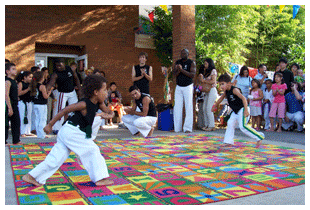Capoeira, Capoeira!

- SUBSCRIBE
- ALREADY SUBSCRIBED?
BECOME A BONJOUR PARIS MEMBER
Gain full access to our collection of over 5,000 articles and bring the City of Light into your life. Just 60 USD per year.
Find out why you should become a member here.
Sign in
Fill in your credentials below.
an intensely bright five year old who lives in Atlanta, is awesome. He
never fails to amaze me, whether it’s with his incredible intelligence,
or his sunny disposition. On a recent trip home, he greeted me with his
usual cheery smile and warm hug, then proceeded to show me his ginga. I
stood there with my mouth agape wondering what kind of chocolate he’d
gotten into.
“What’s going on, Noah?” I asked him.
“Aunt Prissy, I’m doing the ginga. This is Capoeira.”
“What’s Capoeira?” I asked, embarrassed; I could barely even pronounce the word.
“It’s this!”
And just like that Noah started spinning on his head right there on my Mom’s living room floor.
Noah’s
parents, my sister Deirdre and her husband Emanuel, practice Capoeira
also. They informed me that Noah is the youngest person in Mestre
Robson DeJesus’s class at Abba Capoeira. My other sister Janay does the
ginga, too. By the way, the ginga, as I’ve come to learn, is the basic
Capoeira move in which the player shifts his body from side to side.
(In Brazil one plays Capoeira, rather than practices it.). Capoeira has
turned into a real family affair back at home, and now I understand why.
 As
As
they further explained to me, Capoeira started off in Brazil as a dance
for slaves, who tried to mask their fighting by incorporating it with
dance moves. To the slave-owners, it looked like harmless dancing. The
slaves played music during Capoeira sessions to teach the dancers the
rhythmic heart of the art and also to mask its power. However,
eventually, the slave-owners caught on to what they were doing and
outlawed Capoerira. Luckily, it has been preserved nonetheless. For
many people, it’s still only dance, but for others, it is martial arts;
and still for others, it’s both. In either case, Capoeira is now an
international form of artistic expression that’s gaining massive
attention in many countries.
Still scratching my head an hour
later, and reminiscing of the days when I had aspired to be like Bruce
Lee, I asked Noah if he would like to come back to France and stay with
me for a couple of weeks. His answer: “Only if there’s a place for me
to practice Capoeira.”
Ok. I decided that I had to come back to
France and find a Capoeira centre so that I could get Noah over here to
visit. I’ve found several locations, in which the people have been
extremely kind and helpful. That’s another thing about Capoeria: there
seems to be a real brotherhood, as if the people who practice it are
one big family. It’s very social, as well as being a beautiful art.
With all the handstands, cartwheels, spins and body twists, all done to
great music, it looks incredibly fun and very relaxing. And it’s
Brazilian, too, so you can’t go wrong, can you?
There are
several martial arts centres in Paris that teach and practice Capoeira.
I’ve listed just a few of the addresses so that if you, like my nephew,
are visiting Paris, you’ll have a place to continue your art. And now
I’ll go and call Noah and tell him that he can indeed come back to
France again and hang out with me. I can reassure him that there are
plenty of centres here in Paris where he can practice his ginga.
Ecole des Danses Latines et Tropicales
170 bis, rue du Fbg St Antoine
75012 Paris
Entrance: 40, rue de Citeaux
M° Faidherbe Chaligny (ligne 8) ou Reuilly Diderot (ligne 1)
Phone: 01.43.72.26.26
E-mail:
21, rue de l’amiral Roussin
75015 PARIS
Tél: 01 43 06 38 87
Fax: 01 44 49 08 05
E-mail: [email protected]
A true Southern Belle who grew up in Alabama, Priscilla Lalisse now lives with her French husband and son in Paris.


